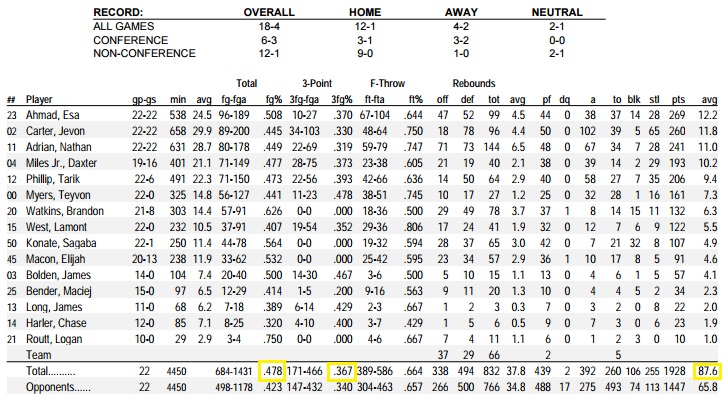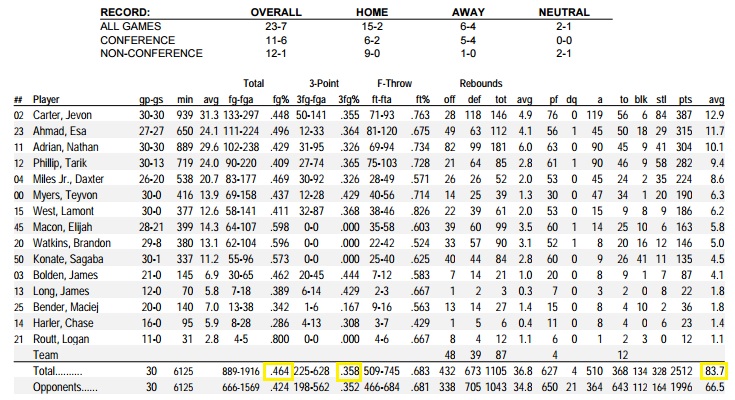Whoa, offensive woes
March 1, 2017 by Mike CasazzaWest Virginia v. Iowa State is a useful game because it gives me bookends for this conversation. The Mountaineers entered February with momentum coming from a promising win at Iowa State. Things were looking good for them, and remember they changed their spots and played small to score points and win at Hilton Coliseum.
Here’s the season box score on the first day of February.

In the eight games after scoring 85 points, shooting 48 percent and making 10 3-pointers at Iowa State, WVU is averaging 73 points, shooting 42 percent and making 6.7 3s per game. The season’s three lowest point totals and shooting percentages can be found in those eight games.
The season box score on the first day of March is different.

That’s almost four points per game shaved off the average — and remember, WVU played three overtime periods in those eight games. The shooting percentage and the 3-point percentage have dipped, too, but I wonder if you see something else I did not highlight.
I’ll wait.
The opponents are performing at a remarkably similar level. The shooting percentage is almost identical. The rebounding average is identical. The scoring average is up, but Kansas and Texas Tech had 15 extra minutes. Opponents shoot 3-pointers a bit better, but the big one is the free-throw shooting. The accuracy is way up, which WVU has no say over, but the attempts … goodness. In eight games, teams are outshooting WVU 221-159 and outscoring WVU 162-120. Opponents have made more free throws than WVU has attempted, and that is absolutely affecting defenders and even the defense. It’s why we’re seeing a room temperature press and a 1-3-1.
Combine all of that with the fact WVU’s rebounding is down, too.
The Mountaineers are 5-3 in those eight games and one slightly better Texas Tech or TCU possession away from being at or below .500 last month (and one slightly better Tarik Phillip possession away from being 6-2).
All of which brings me to this. The arrow is not pointing down, but it’s bending, bending, bending. The weak spots aren’t new, but the Mountaineers found and knew ways to work with and around them before. That’s not happening as much or as well now, and Monday night’s loss suggested something that might as well be reality.
Baylor had ways to exploit WVU, and WVU struggled in familiar areas, but the opposition in the Big 12 and NCAA tournaments could find one of those threads and pull. How long the Mountaineers last will surely depend on how much better they are at damage control than they were inside the Ferrell Center.
“There’s not any reason why we didn’t go rebound the ball,” coach Bob Huggins said. “They’re good. They’re talented, they’re big and they’re long and all that, but we found ways to rebound it against them before.”
Baylor (24-7, 11-6) outrebounded WVU 43-23, but the Bears are No. 6 nationally in rebounding margin. The Mountaineers are No. 95 out of 351 teams. One of the best at offensive rebounds (No. 4), WVU is one also of the worst at defensive rebounds (No. 322).
In the first half of Saturday’s win at TCU, the Mountaineers were outrebounded 21-12, and Huggins thought “our guys were like they were at the movies” as they chose to watch rather than rebound. His guys won the second half by seven rebounds, and WVU won the game by a point.
Monday was the ninth time the Mountaineers have been outrebounded but the second time they’ve lost.
“We need more intensity,” forward Elijah Macon said. “Everyone has to come out wanting to win the game. Everyone has to have that want. There’s no reason you can’t box out, whoever it is, even if it’s not your man. You have to go in there and hit somebody.”

